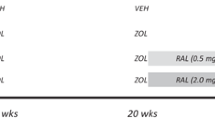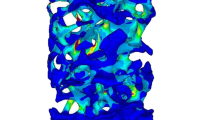Abstract
Reduced bone toughness, the energy absorption capacity of the tissue, has been consistently documented in vertebrae of animals treated with a wide range of bisphosphonate doses. Data regarding toughness changes in the rib are conflicting, with one report showing no effect and another showing a significant reduction following treatment of beagle dogs with high doses of bisphosphonates. The goal of this study was to evaluate changes in bone toughness and various other tissue-level properties of the rib following 3 years of bisphosphonate treatment with doses at and above those used to treat osteoporosis. Skeletally mature intact beagle dogs were treated daily for 3 years with vehicle (VEH), alendronate 0.2 mg/kg (ALN0.2), or alendronate 1.0 mg/kg (ALN1.0). The lower ALN dose approximates, on a milligram per kilogram basis, that used for treatment of postmenopausal osteoporosis, with the higher dose being five times higher. Ribs were assessed for biomechanical properties, bone turnover rate, microdamage, density, and geometry. Toughness was significantly lower with ALN1.0 (−33%) but not ALN0.2 (−19%) compared to VEH, while neither ultimate stress nor modulus differed among the groups. Bone density, geometry, and structural biomechanical properties were similar among the three groups. There was no significant difference in overall microdamage accumulation among the groups. Intracortical bone formation rate was significantly lower than VEH in both ALN groups (−69% to −90%). These data show that while rib cortical bone experiences significant reductions in turnover following bisphosphonate treatment, it is only in animals treated with doses above those used to treat osteoporosis that toughness is significantly compromised.


Similar content being viewed by others
References
Allen MR, Iwata K, Phipps R, Burr DB (2006) Alterations in canine vertebral bone turnover, microdamage accumulation, and biomechanical properties following 1-year treatment with clinical treatment doses of risedronate or alendronate. Bone 39:872–879
Mashiba T, Turner CH, Hirano T, Forwood MR, Johnston CC, Burr DB (2001) Effects of suppressed bone turnover by bisphosphonates on microdamage accumulation and biomechanical properties in clinically relevant skeletal sites in beagles. Bone 28:524–531
Allen MR, Burr DB (2007) Three years of alendronate treatment results in similar levels of vertebral microdamage as after one year of treatment. J Bone Miner Res 22:1759–1765
Komatsubara S, Mori S, Mashiba T, Ito M, Li J, Kaji Y, Akiyama T, Miyamoto K, Cao Y, Kawanishi J, Norimatsu H (2003) Long-term treatment of incadronate disodium accumulates microdamage but improves the trabecular bone microarchitecture in dog vertebra. J Bone Miner Res 18:512–520
Mashiba T, Hirano T, Turner CH, Forwood MR, Johnston CC, Burr DB (2000) Suppressed bone turnover by bisphosphonates increases microdamage accumulation and reduces some biomechanical properties in dog rib. J Bone Miner Res 15:613–620
Komatsubara S, Mori S, Mashiba T, Li J, Nonaka K, Kaji Y, Akiyama T, Miyamoto K, Cao Y, Kawanishi J, Norimatsu H (2004) Suppressed bone turnover by long-term bisphosphonate treatment accumulates microdamage but maintains intrinsic material properties in cortical bone of dog rib. J Bone Miner Res 19:999–1005
Komatsubara S, Mori S, Mashiba T, Li J, Nonaka K, Kaji Y, Akiyama T, Miyamoto K, Cao Y, Kawanishi J, Norimatsu H (2005) Suppressed bone turnover by long-term bisphosphonate treatment accumulates microdamage but maintains intrinsic material properties in cortical bone of dog rib (JBMR Anniversay Classic reprint). J Bone Miner Res 20:2066
Allen MR, Follet H, Khurana M, Burr DB (2006) Anti-remodeling agents influence osteoblast activity differently in modeling- and remodeling-associated bone formation Calcif Tissue Int 79:255–261
Martin RB, Yeh OC, Fyhrie DP (2007) On sampling bones for microcracks. Bone 40:1159–1165
Parfitt A, Drezner M, Glorieux F, Kanis J, Malluche H, Meunier P, Ott S, Recker R (1987) Bone histomorphometry: standardization of nomenclature, symbols, and units. J Bone Miner Res 2:595–610
Turner CH, Burr DB (1993) Basic biomechanical measurements of bone: a tutorial. Bone 14:595–608
Currey J (2004) Incompatible mechanical properties in compact bone. J Theor Biol 231:569–580
Allen MR, Burr DB (2008) Changes in vertebral strength–density and energy absorption–density relationships following bisphosphonate treatment in beagle dogs. Osteoporos Int 19:95–99
Recker RR, Weinstein RS, Chesnut CH 3rd, Schimmer RC, Mahoney P, Hughes C, Bonvoisin B, Meunier PJ (2004) Histomorphometric evaluation of daily and intermittent oral ibandronate in women with postmenopausal osteoporosis: results from the BONE study. Osteoporos Int 15:231–237
Bone HG, Hosking D, Devogelaer J-P, Tucci JR, Emkey RD, Tonino RP, Rodriguez-Portales JA, Downs RW, Gupta J, Santora AC, Liberman UA, Alendronate Phase III Osteoporosis Treatment Study Group (2004) Ten years’ experience with alendronate for osteoporosis in postmenopausal women. N Engl J Med 350:1189–1199
Acknowledgements
The authors thank Dr. Keith Condon, Diana Jacob, and Lauren Waugh for histological preparation. This work was supported by National Institutes of Health grants AR047838 and AR007581. Merck kindly provided the alendronate. This investigation utilized an animal facility constructed with support from the Research Facilities Improvement Program (grant C06 RR10601–01) from the National Center for Research Resources, National Institutes of Health.
Author information
Authors and Affiliations
Corresponding author
Rights and permissions
About this article
Cite this article
Allen, M.R., Reinwald, S. & Burr, D.B. Alendronate Reduces Bone Toughness of Ribs without Significantly Increasing Microdamage Accumulation in Dogs Following 3 Years of Daily Treatment. Calcif Tissue Int 82, 354–360 (2008). https://doi.org/10.1007/s00223-008-9131-8
Received:
Accepted:
Published:
Issue Date:
DOI: https://doi.org/10.1007/s00223-008-9131-8




